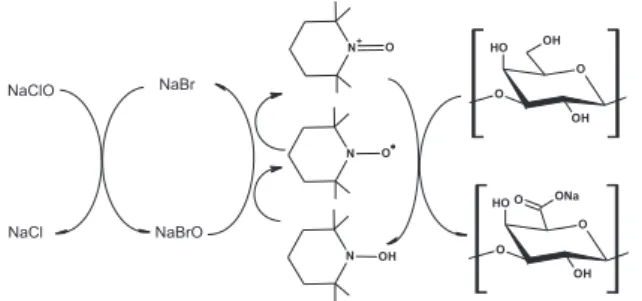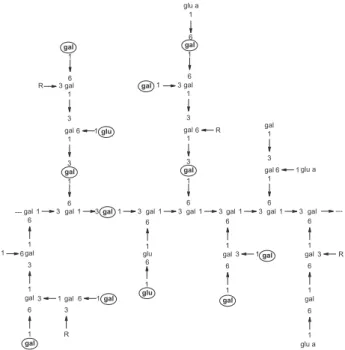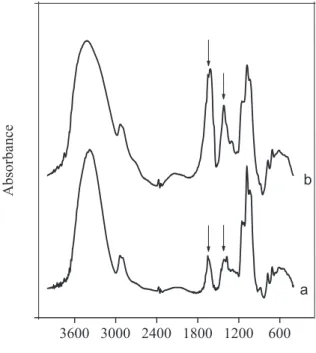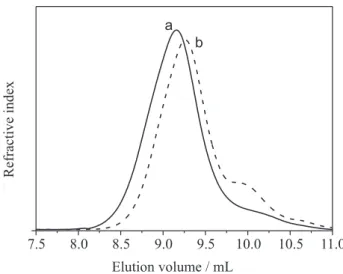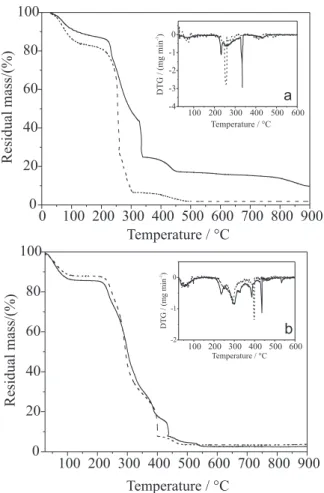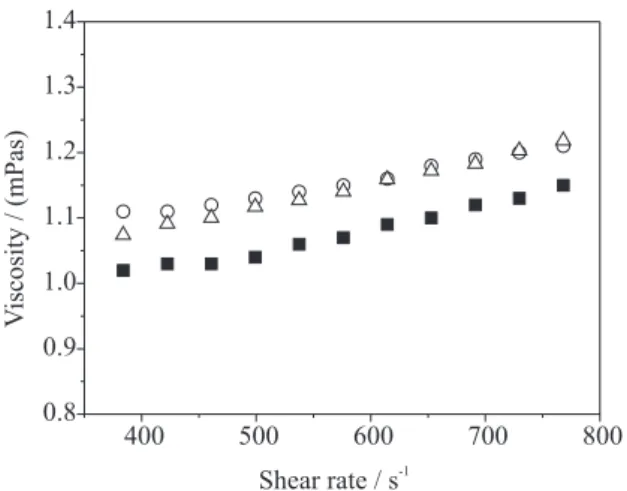Printed in Brazil - ©2007 Sociedade Brasileira de Química 0103 - 5053 $6.00+0.00
Article
*e-mail: judith@dqoi.ufc.br
Oxidation of Cashew Tree Gum Exudate Polysaccharide with TEMPO Reagent
Pablyana L. R. Cunha,a Jeanny S. Maciel,a Maria Rita Sierakowski,b Regina C. M. de Paulaa and
Judith P. A. Feitosa*,a
a
Departamento de Química Orgânica e Inorgânica, Universidade Federal do Ceará, CP 12200, 60455-760 Fortaleza-CE, Brazil
b
Departamento de Química, Universidade Federal do Paraná, Curitiba-PR, Brazil
A goma do cajueiro, um polissacarídeo exsudado da árvore Anacardium ocidentale, foi oxidada com o reagente TEMPO e o produto (CGOX) foi caracterizado por técnicas espectroscópicas (FT-IR e RMN), análises cromatográficas (HPLC e GPC), viscosidade e análise térmica (TGA). O rendimento do produto da reação foi de 96%. O teor de ácido urônico da goma nativa (7,2%) aumentou para 36% após a reação. O grau de oxidação, tendo como base as unidades de galactose e glucose livres, foi de 68%. Os dados de RMN mostraram que a oxidação ocorreu preferencialmente nos carbonos primários das unidades de galactose. A grande diferença entre o valor esperado de ηCGOX/ηCG e o valor observado indica que a degradação, durante a oxidação, ocorreu em grande extensão. A presença de impurezas orgânicas e inorgânicas no novo polieletrólito foi detectada por TGA. A goma do cajueiro após a modificação com TEMPO apresentou mais baixa estabilidade térmica que a goma nativa, indicada pelos valores de temperatura inicial de decomposição e IPDT.
Cashew gum (CG), an exudate polysaccharide from Anacardium ocidentale trees, was oxidized with TEMPO reagent and the 7product (CGOX) characterized by spectroscopic techniques (FT-IR and NMR), chromatographic analyses (HPLC and GPC), viscosity measurements and thermal analysis (TGA). The yield of the reaction product was 96%. The uronic acid content in starting gum (7.2 m%) was increased to 36 m%. The degree of oxidation based on free galactose and glucose units was 68%. NMR data show that oxidation occurred preferentially at primary carbons of galactose units. High degradation degree after oxidation was estimated by the difference on the expected and observed ηCGOX/ηCG ratio.The presence of organic and inorganic impurities in the new polyelectrolyte was detected by TGA. A less thermally stable cashew gum is formed after the oxidation with TEMPO based on initial decomposition temperature and IPDT.
Keywords: cashew gum, oxidation, TEMPO, Anacardium occidentale, polysaccharide
Introduction
In the recent decade, catalytic oxidation of carbohydrates using the stable nitroxyl radical 2,2,6,6-tetramethylpiperidine-1-oxyl (TEMPO) has become one of the most promising procedures to convert polysaccharides into the corresponding polyuronic acids.1,2 Contrary to
enzymatic or metal-catalyzed oxidation, the TEMPO-oxidation process is highly effective in the conversion of high molecular weight polysaccharides. Direct oxidation of hydroxyl groups provides interesting routes for the introduction of carbonyl and carboxyl groups into polysaccharides.2 The TEMPO presents many advantages
as reagent for oxidation, such as chemical stability in the presence of air, light or moisture, and the possibility of storage without special conditions, differently of a great number of reagent used for oxidation.3
The conversion of primary alcohols to carboxylates proceeds via a reactive aldehyde-intermediate, which is present at low concentration throughout the oxidation.1
Regeneration of the nitrosonium salt, which is the active oxidizing species, takes places in situ by the use of a suitable primary oxidant, e.g. sodium hypochlorite with catalytic amounts of sodium bromide.4 A highly selective
obtained in high yields.5 A schematic representation of
TEMPO oxidation process is depicted in Figure 1.
Several publications describe procedures for oxidation with TEMPO of various polysaccharides, such as starch,5
galactomannans,7,8 inulin and pullulan,8 chitin,9 chitosan,
potato amylose and amylopectin,10 hyaluronan,11
sclero-glucan,12 galactoxyloglucan.13 A number of applications have
been described for these oxidized carbohydrates. They rely on some of their specific properties, ranging from gelation, to complexation, antiflocculation, adhesion, as well as varied biological activity.7,14
Cashew gum (CG) is an exudate polysaccharide from
Anacardium occidentale trees. Our group has been studied this gum since 1993.15 The gum was characterized
as a heteropolysaccharide containing galactose (72-73%), glucose (11-14%), arabinose (4.6-5%), rhamnose (3.2-4%) and glucuronic acid (4.7-6.3%) in mass%.16,17
CG is mainly composed of three types of galactan units within the core, linked by C-1 and C-3; C-1 and C-6 and C-1, C-3 and C-6. The glucose is present as a side chain, with up to five units long.17
Some application based on CG has been proposed in last few years, such as superabsorbent hydrogel as soil conditioner,18 polyelectrolyte complex with chitosan for
drug delivery.19 The polysaccharide has also been modified
by carboxymethylation with monochloroacetic acid as the etherifying agent.20 Brazil has approximately 680,000 ha
of planted area with cashew nut tree.21 The average
production of gum/tree/year is 700 g,22 with the potential
annual CG production of 38 thousands of ton.
The purpose of this work is to prepare and characterize an oxidized cashew gum in order to increase the polyelectro-lyte character and amplify the possibilities of CG application.
Experimental
Materials
Crude samples from cashew gum (CG) were collected from native trees at Fortaleza, Ceará, Brazil. They were
purified as a sodium salt using the method previously described.17,23 Nodules free of bark were selected and
dissolved in distilled water at room temperature to give a 5% (m/v) solution. The solution pH was adjusted to approximately 7.0 by addition of diluted aqueous NaOH. The clear solution was successively filtered through sintered glass and the polysaccharide precipitated with ethanol. TEMPO (2,2,6,6-tetramethypiperidine-1-oxyl) was supplied by Sigma Corporation.
Oxidation of cashew gum
Cashew gum was oxidized as previously reported by Sierakowski et al.7 and briefly described here. The cashew
gum (1 g of polysaccharide) was dissolved in 1 L of distilled water. TEMPO (0.020 g or 0.13 mol) and NaBr (0.1 g or 0.95 mmol) were added and the solution on stirring was cooled in an ice bath and maintained at 5 ± 1 °C. A 15% sodium hypochlorite solution (6 mL or 12.5 mmol) was added to the polymer solution, then the pH was adjusted to 9.3 with 2 mol L-1 HCl solution. During the oxidation process (1 h) the pH
was maintained at 9.3 by addition of a 0.05 mol L-1 aqueous
NaOH solution. To stop the reaction sodium borohydride (50 mg ) was added and the reduction process was effected for 45 min. The pH of the mixture was adjusted to 8 by addition of HCl, and the polyelectrolyte precipitated with 2 volumes of EtOH in presence of NaCl (up to 10 g L-1). The product
(CGOX) was isolated by centrifugation, washed several times with EtOH, filtered, dried, and its yield was calculated.
Characterization of unmodified and oxidized cashew gum
Analytical data
CG and CGOX were hydrolyzed with TFA at 100 °C for 6 h. To eliminate the excess of acid, MeOH was added
(5 × 5 mL). A HPLC Shimadzu equipment, with a
Phenomenex column Rezex 8µ 8% H. Org. Acid (7.8 × 300 mm), flow 0.5 mL min-1 and 8 mmol L-1 H
2SO4 as
eluent was used to analyze the hydrolyzed material. A differential refractometer was employed as detector.
The uronic acid content was measured after samples hydrolysis and subsequent reaction with 3-hydroxy-biphenyl, considering the absorbance at 520 nm. A galacturonic and glucuronic standard curves (absorbance
vs concentration) was used.24
Infrared spectral analysis
The Fourier transform IR spectra (FT-IR) were recorded with a Shimadzu IR spectrophotometer (model
8300) in the wavenumber range of 400 and 4000 cm–1
and with samples as KBr pellet.
Nuclear Magnetic Resonance (NMR)
13C NMR spectra of 5% (m/v) solutions in D
2O at 80 °C
were recorded in a Bruker Model Avance DRX500 spectrometer. Chemical shifts were given in values relative to DSS at 0 ppm. A distortionless enhancement through polarization transfer (DEPT) spectrum was recorded in order to determine the multiplicity of carbon peaks; the acquisition and delay times were 1.0 s. DEPT spectrum was obtained with final 1H pulse flip angle of 135° (DEPT
135). The signals in the 13C NMR spectrum were assigned
based on literature data for correlated compounds.17 For
the NMR experiments 1H (number of scans, ns = 8),13
C-BB (ns = 6000) and 13C-DEPT (θ = 135°, ns = 3000).
Molar mass distribution
The molar mass distribution was estimated by gel permeation chromatography (GPC) with Shimadzu equipment at room temperature (around 28 °C) using an Ultrahydrogel linear column (7.8 × 300 mm), flow 0.5 mL min-1, 0.5% polysaccharide concentration and 0.1 mol
L-1 aqueous NaNO
3 as solvent. A differential refractometer
was used as detector.
Rheological studies
Rheological studies of CG and CGOX aqueous solution (1%, m/v) were performed in a Rheometer Brookfield cone-plate model LV-DVIII at 25 °C. The effect of shear rate on the solutions viscosity was evaluated. The effect of temperature was investigated for 1% aqueous solutions by heating from 20 to 55 °C, with measurement of viscosity at shear rate 768 s-1 and in interval of 3 °C.
Thermal analysis
TGA measurements of samples were carried out using a Shimadzu TGA-50 instrument at a heating rate of 10 °C min-1 over a temperature range of 25-900 °C. The flow
rate of air was maintained at 50 mL min-1 and the initial
sample weight was 10 mg.
Results and Discussion
Analytical data
The yield of the oxidation product of cashew gum (96%) is in the range of those found for the oxidation with TEMPO of most polysaccharide, such as pullulan, amylopectin, amylose, starchs, hyaluronan, scleoroglucan, inulin and chitosan (87-100%).2
The uronic acid content, determined by colorimetric titration, was 7.2 m% for unmodified cashew gum, slightly superior than the range reported in previous work
(4.7-6.3%).16,17 After oxidation, this content increased to 36 ±
3%. The uronic acid content could be used to calculate the degree of oxidation (DO), expressed as the average fraction of modified monosaccharide unit. The calculated DO of cashew gum is 0.27. The DO sometimes is determined based not on the total monosaccharide unit but on the free units.7
Taking in consideration the probable fragment of the cashew gum polysaccharide structure, as proposed by Anderson and Bell25 with adaptation due to further study with
Brazilian gum,17 shown in Figure 2, the free galactose,
glucose and mannose (bold letter) represent about 40% of total monosaccharide units. The new DO for cashew gum, calculated on the base of free units, is 0.68. Comparison of this result with those reported for galactomanans oxidized by the same experimental procedure7 could be seen in Table
1. The DO (from free units) obtained to CGOX is in the same order of magnitude of Leucaena galactomannan and higher than the DO of Cassia fastuosa gum.
The analysis by HPLC of unmodified CG after hydrolysis (data not shown) confirms the presence of glucuronic acid, as detected previously.17,25 In the CGOX
Table 1. Comparison among degree of oxidation of different polysac-charides
Sample DOa DOb Reference
cashew gum 0.27 ~ 0.68 present work
Cassia fastuosa galactomannan 0.13 0.22 7
Leucaena galactomannan 0.48 0.62 7
chromatogram, the peak of glucuronic acid remains and one attributed to galacturonic acid appears. The content of each uronic acid in oxidized gum was not calculated, but the proportion of the peak areas indicates that the oxidation was mostly done in C-6 of galactose to lead galacturonic acid.
Infrared spectroscopy
The oxidized CG sample and starting gum were obtained in salt form. The FT-IR spectra of CG and CGOX show similar bands, such as those at 3700-3000 cm-1 (OH
stretching vibration), 2924 and 2893 cm-1 (symmetric and
asymmetric CH stretching), 1415 cm-1 (OH bending), and
1200-800 cm-1 (C-O and C-C stretching vibrations of the
hexopyranosyl) (Figure 3). Spectral differences could be seen in the bands at 1620 and1430 cm-1, attributed to
asymmetric and symmetric stretching of carboxylate groups. The shoulder at 1650 cm-1 could also be due to
OH vibration from polysaccharide moisture.14 The
existence of bands attributed to -COO– in unmodified CG
spectra comes from the small amount of glucuronate (4.7-6.3%).16,17 The increase in the band intensity related to
carboxylate groups of the modified gum (1620 and1430 cm-1) confirms the oxidation of the polysaccharide.
Galactomannan,7Aspergillusniger and Trichoderma reesei
polyuronans26 and also cellulose14 showed increase in
intensity or appearance of band due to asymmetric stretching of -COO– in the same range (1608-1618 cm-1)
after oxidation with TEMPO. The symmetric stretching was observed at 1400 cm-1 in oxidized cellulose.14
NMR
Figure 4 shows 13C NMR spectra of the unmodified
(CG) and oxidized cashew gum (CGOX). CG spectrum is similar to that obtained by de Paula et al.,17 with
signals of anomeric carbons of β-D-galactose (1→3) (104.4 ppm), β-D-galactose (1→6) (105.3 ppm), α -D-glucose (101.1 ppm), α-L-arabinose (105.5 ppm); α
-L-rhamnose (101.7 ppm) and β-D-glucuronic acid
(103.5 ppm). A DEPT 135º experiment was used to identify the oxymethylene groups as in this pulse sequence signals of the carbons bearing two protons
have opposite amplitude to the CH and CH3 carbons
(Figure 5a). It can be depicted from Figure 5a four signals at chemical shift at 61.3 and 62.4 ppm arise from CH2OH groups. CH2 signal observed at 70.3 ppm is due to 6-O-substitution of galactose that shift primary
carbons in the range of 6-11 ppm.17 Signal from
carbonyl groups was not observed at the spectrum of
CG (Figure 4a) due to the low proportion of this unit in
unmodified gum. 13C NMR spectrum of oxidized gum
(Figure 4b) shows a peak at 175.5 ppm due to carboxylate carbons and a drastic decrease of C-6 primary carbons in the region of 61 to 63 ppm, confirming the oxidation of primary carbons. In CGOX DEPT 135º spectrum (Figure 5b) the presence of signal due to 6-O-substituted galactose units (70.3 ppm) indicates that this unit was not eliminated by TEMPO-mediate oxidation reaction. The α-1,6 linked glucose bonds present in the original starch sample are cleaved
by TEMPO-mediate oxidation reaction.5,14 In the
anomeric region of CGOX spectrum it can be also depicted an increase of signals at 103.4-103.7 ppm, attributed to the C-1 of β-D-galacturonic acid,27
corroborating the HPLC results. The appearance of new peaks at 98.1 and 94.6 ppm is consistent with chemical shift expected for α and β configuration of reducing galactose end-unit17 and indicates that degradation
occurs to about 8% of total anomeric carbons areas. The loss of arabinose units and some glucose units, also, confirms degradation.
area and a concomitant increase of 82.4% of C-1 of β- D-uronic acid signal was observed, indicating that oxidation occurs preferentially at primary carbons of galactose units.
Molar mass distribution
The distribution of molar mass of unmodified and oxidized CG is depicted in Figure 6. Two differences could be noted in CGOX chromatogram: shift of peak to higher elution volume (9.26 mL) when compared to CG (9.15 mL) and the appearance of a shoulder at 9.93 mL.
The oxidized polysaccharide is expected to elute at a lower volume than the starting polymer, if no chain length degradation has occurred. This is due to chain stiffening and extent, as a consequence of electrostatic repulsion of carboxylate groups. Another contribution is the increase in molar mass expected for CGOX, due to substitution of CH2OH groups (molar mass of 31 g mol-1) for -COONa
(molar mass of 67 g mol-1) at each monosaccharide unit
oxidation. The shift of oxidized gum to higher elution volume (curve b) than that unmodified gum (curve a) and
the appearance of a shoulder indicates that chain scission occurs during the oxidation.
Reduction on molar mass during the oxidation with TEMPO was also observed with other polysaccharides, such as hyaluronate,11 galactoxyloglucan13 and pullulan.29
The molar mass diminishing is small in pullulan and registered as to a half value in hyaluronate derivatives. In the oxidation of galactoxyloglucan a new peak in GPC chromatogram also appears in elution volume higher than the original gum.
Thermal analysis
Thermogravimetric curves of oxidized cashew gum are depicted in Figure 7a. The curve in solid line represents the analysis of CGOX as obtained from procedure described in experimental section. The high residual mass at 900 ºC (9.8%) and the mass lost at temperature higher than 600 ºC indicate that the oxidized sample contains impurities not eliminated during the experimental procedure. To confirm this assumption the CGOX sample was dialyzed against distilled water at ambient temperature until the conductivity of water reaches the original distilled water value (3 mS cm-1) and then freeze dried. The TGA
curve of dialyzed CGOX sample was exhibited in Figure 7a as dash line. The residual mass at 900 °C diminishes to 4.4% and the event in the ranges 800-900 ºC disappeared in purified oxidized gum. This is a confirmation of the presence of impurities in CGOX sample.
The impurities could be originated from cashew gum and/or from the oxidation process. The original unmodified cashew gum was dialyzed and the obtained thermogravimetric curves of samples are showed in Figure 7b. The difference between the original gum (solid line)
Figure 4.13C NMR spectra of: (a) unmodified cashew gum; (b) oxidized
product.
Figure 5.13C DEPT 135 NMR spectra of: (a) unmodified cashew gum;
(b) oxidized product.
Figure 6. GPC curve of: (a) unmodified and (b) oxidized cashew gum solutions in 0.1 mol L-1 NaNO
and the dialyzed gum (dash line) was only significant in the range of 400-450 ºC, as could be better noted in DTG curves. So, the impurities of CGOX are originated predominantly from the oxidation process and not from the starting CG gum.
The analysis of the experimental procedure suggests that a possible contaminant could be NaCl. The evaporation process of this salt begins at 700 °C and finish at 850 °C.30 The mass lost in this range of temperature is,
so, attributed to the presence of NaCl in CGOX, estimated in around 5.3%. The change in the curve profile between 250 and 450 °C is probably due to organic contaminant, remained from the oxidation procedure.
The comparison between thermograms reveals that the thermal decomposition process of CG and CGOX dialyzed samples are different. The oxidized gum presents a event of water loss (up to 150 ºC), a main degradation event, with temperature of maximum decomposition (Tm) at 257 ºC, a slow process of mass loss between 260 and 300 °C and a last event up to 480 °C. Unmodified cashew gum exhibited three events, in
Tm at 246, 290 and 398 ºC, beside the water loss up to 150 ºC (Table 2). Cashew gum is a complex hetero-polysaccharide and its mechanism of thermal decom-position is unknown. Generally, dehydration, depolyme-rization, decarbonylation and pyrolitic decomposition, with the evolution of H2O, CO, CO2, and CH4 are
involved in anionic gum thermal decomposition.31
However, because of the differences in structure and functional groups, either the degradation routes or the resulting fragments will be different.
The thermal stability is an important characteristic of materials. This stability could be determined by some parameters, such as Ti (initial decomposition temperature), Tm, IPDT (integral procedure decomposition temperature), and others.32 The shift of T
i and IPDT to lower
temperatures demonstrates that the oxidation reduces the thermal stability of cashew gum (Table 2), as observed also with oxidized galatoxyloglucan.13 According to Viletti
et al.,33 in general, neutral polysaccharides showed higher
thermal resistance than charged polyanions. So, the charge increase by oxidation leading to a decrease in thermal resistance could be expected.
Rheological studies
Aqueous solutions of CG and CGOX (dialyzed and not dialyzed) have low viscosity (Figure 8). The value of viscosity reported in literature for cashew gum solution at 1% (m/v), 1.0 mPa s,16 is similar to that obtained in the
present work. The oxidation promotes a small increase in viscosity of approximately 0.1 mPa s. A higher increase was expected, if only the increase in uronic acid from 7.2 to 36% was taking into account. The higher negative charge induces more repulsion between chains and a more expanded macromolecular conformation. The smaller increase in viscosity than was supposed is, probably, due to chain scission, as already commented in GPC analysis. Another contribution could be due to the remained salt, as detected by thermogravimetric analysis. The viscosity of dialyzed sample solution is similar to that of non dialyzed gum in the shear rate range of 600 to 800 s-1. A
small increase was observed in shear rate below 600 s-1. Table 2. Parameters from TGA and DTG curves of the unmodified and oxidized cashew gum after dialysis
Sample Ti / ºC Tm / °C residual IPDT/ °C
I II III IV mass/(%)
CG 209 64 246 290 398 3.1 301
CGOX 191 65 257 - - 4.4 259
So, the small difference between unmodified and oxidized gum is predominantly due to chain degradation.
The expected viscosity of CGOX, if no chain scission had occurred, could be estimated based on the proposition made by Reed et al.34 that the intrinsic viscosity, [η], of
variably ionized polyacrylate varies as ξ/Cs0.5, where ξ is
the Manning charge parameter and Cs is the univalent electrolyte concentration in mmol L-1. Taking into account
a constant salt concentration, [η] could be considered proportional to ξ. The following relationships are proposed:
(1)
The content of uronic acid is 7.2% and 36% in CG and CGOX, respectively. The intrinsic viscosity of cashew gum20 in 0.1 mol L-1 aqueous NaCl is 0.84 dL g-1 and so,
the expected [η]CGOX is 4.2 dL g-1.
The dependence of solution viscosity with concentration for dilute solutions is given by the relation34
η = η0 + [η]cη0 + kH[η]2c2η
0 (2)
where η0 is the solvent viscosity, c the polymer solution concentration and kH the Huggins constant.
The equation 2 could be applied for CGOX and CG at gum concentration of 1g dL-1 and reduced to the equation 3.
(3)
Taking into account that the electrostatic screening was high enough to reduce the classical increase of
viscosity at low polymer concentration, kH was taken by Reed et al.34 as around 0.5. Applying [η]
CGOX and [η]CG, as
4.2 and 0.84 dL g-1, respectively, and k
H as 0.5 in equation
3, the solution viscosity of CGOX without degradation was estimated as 6.4 times the viscosity of CG, both at 1 g dL-1 polysaccharide concentration and ionic strength of
0.1 mol L-1. Without the addition of salt the enhancement
in the viscosity of oxidized gum solution is expected to be more than 6.4 in comparison with CG solution. The increase in ηCGOX of only 10% points to the occurrence of a high degree of chain degradation.
The effect of temperature on the viscosity of 1% CG and CGOX aqueous solutions was investigated at a temperature range of 20 - 55 ºC. Arrehnius-Frenkel-Eyring equation35 was applied to the data of η
CGOX and ηCG and a
plot of lnηvs. T-1 (in Kelvin) was obtained (Figure 9). From
the slope of the lines, it was possible to calculate the apparent activation energy of flow (Ea) of 12.3 and 11.6 kJ mol-1 for unmodified gum and oxidized gum solutions,
respectively. The Ea value for 2% aqueous solution of cashew gum is 15.6 kJ mol-1,16 characteristic of branched
polysaccharide with few inter- and intra-interactions between polymer chain.23 Low value was expected for 1%
solution, because Ea decreases with solution concentration.35
The small activation energy of flow for oxidized gum could be due to chain degradation given molar mass less than 104
g mol -1 and the contribution of fraction of very low molar
mass, as indicated by the shoulder in GPC. The molar mass of cashew gum is in the order of 105 g mol -1.20
Conclusions
The oxidation of cashew gum with TEMPO has a high product yield (96%) and promotes the increase of uronic acid content from 7.2 (starting gum) to 36 m%. This represents the carboxylation of 68% of the free galactose
Figure 8. Effect of shear rate on the viscosity of aqueous solutions: () unmodified cashew gum; (U) oxidized and non dialyzed CG; (c) oxi-dized and dialyzed CG. Gum concentration, 1.0% (m/v) at 25°C.
and glucose units. The oxidation occurs preferentially at primary carbons of galactose units. The aqueous solutions of oxidized and unmodified gum have similar low viscosity. The small augment of 10% in the solution viscosity due to oxidation is caused by the effect of high degree of chain degradation that overcomes almost all effect of chain expansion of a more negative polysaccharide formed. A less thermal stable cashew gum is obtained after the oxidation with TEMPO. The high product yield and the substantial increase in polyelectrolyte character amplify the possibility of cashew gum application, in special in those case where high molar mass or viscosity are not required.
Acknowledgments
The authors are thankful to Fundação Coordenação de Aperfeiçoamento do Pessoal de Ensino Superior (CAPES-Brazil) for the fellowship and scientific cooperative program (PROCAD), and Conselho Nacional de Desenvolvimento Científico e Tecnológico (CNPq-Brazil). The authors also wish to acknowledge CENAUREMN (Federal University of Ceará) for recording NMR spectra.
References
1. De Nooy, A. E. J.; Besemer, A. C.; van Bekkum, H.; Tetrahedron
1995, 51, 8023.
2. Bragd, P. L.; van Bekkum, H.; Besemer, A. C.; Top. Catal.2004, 27, 49.
3. De Souza, M. V. N.; Quim. Nova 2004, 27, 287.
4. Anelli, P. L.; Biffi, C.; Montanari, F.; Quici, S.; J. Org. Chem.
1987, 52, 2559.
5. Kato, Y.; Matsuo, R.; Isogai, A.; Carbohydr. Polym. 2003, 51, 69. 6. Sierakowski, M.-R.; Milas, M.; Desbrières, J.; Rinaudo, M.;
Carbohydr. Polym. 2000, 42, 51.
7. Sierakowski, M.-R.; Freitas, R. A.; Fujimoto, J.; Petri, D. F. S.;
Carbohydr. Polym. 2002, 49, 167.
8. De Nooy, A. E. J.; Besemer, A. C.; van Bekkum, H.; Carbohydr.
Res. 1995, 269, 89.
9. Muzzarelli, R. A. A.; Muzzarelli, C.; Cosani, A.; Tjerbojevich,
M.; Carbohydr. Polym.1999, 39, 361.
10. Chang, P. S.; Robyt, J. F.; J. Carbohydr. Chem.1996, 15, 819. 11. Jiang, B.; Drouet, E.; Milas, M.; Rinaudo, M.; Carbohydr.
Polym. 2000, 327, 455.
12. De Nooy, A. E. J.; Rori, V.; Masci, G.; Dentini, M.; Crescenzi,
V.; Carbohydr. Res. 2000, 324, 116.
13. Freitas, R. A.; Martin, S.; De Paula, R. C. M.; Feitosa, J. P. A.; Sierakowski, M.-R.; Thermochim. Acta2004,409, 41.
14. Perez, D. S.; Montanari, S.; Vignon, M. R.; Biomacromolecules
2003, 4, 1417.
15. Rodrigues, J. F.; De Paula, R. C. M.; Costa, S. M. O.; Polímeros:
Ciência e Tecnologia1993, jan/mar, 31.
16. De Paula, R. C. M.; Rodrigues, J. F.; Carbohydr. Polym. 1995,
26, 177.
17. De Paula, R. C. M.; Heatley, F.; Budd, P. M.; Polym. Int. 1998,
45, 27.
18. Guilherme, M. R.; Reis, A. V.; Takahashi, S. H.; Rubira, A. F.; Feitosa, J. P. A.; Muniz, E. C.; Carbohydr. Polym. 2005, 61,
464.
19. Maciel, J. S.; De Paula, R. C. M.; Paula, H. C. B.; Miranda, M. A. R.; Sasaki, J. M.; J. Appl. Polym. Sci. 2006, 99,326. 20. Silva, D. A.; De Paula, R. C. M.; Feitosa, J. P. A.; De Brito, A.
C. F.; Maciel, J. S.; Paula, H. C. B.; Carbohydr. Polym. 2004,
58, 163.
21. http://caju.cnpat.embrapa.br/pif/sistemas/01.htm, accessed in November 2005.
22. Bandeira, C.T.; Relatório Técnico da Empresa Brasileira de
Pesquisa Agropecuária – EMBRAPA-CNPCa, 1991, 6,1.
23. De Paula, R. C. M.; Santana, S. A.; Rodrigues, J. F.; Carbohydr.
Polym. 2001, 44, 133.
24. Blumenkrantz, N.; Asboe-Hansen, G.; Anal. Biochem. 1973, 54, 484.
25. Anderson, D. M. W.; Bell, P. C.; Anal. Chim. Acta1975, 79, 185.
26. Muzzarelli, R. A. A.; Miliani, M.; Cartolari, M.; Tarsi, R.; Tosi, G.; Muzzarelli, C.; Carbohydr. Polym. 2000, 43, 55. 27. Bock, K.; Pedersen, C. In Advances in Carbohydrate Chemistry
and Biochemistry; Tipson, R. S.; Horton, D., eds.; Academic
Press: 1983, vol. 41, p. 27.
28. Howarth, O. R. In NMR Spectroscopy of Polymers; Ibbett, R., ed.; Blackie: Glasgow, 1994, ch. 4.
29. De Nooy, A. E. J.; Besemer, A. C.; van Bekkum, H.; van Dijk, J. A. P. P.; Smith, J. A. M.; Macromolecules 1996, 29, 6541. 30. Liptay, Dv. G.; Atlas of Thermoanalytic Curves, Heyden&Son
Ltd: London, 1973, vol. 1.
31. Zohurian, M. J.; Shokrolahi, F.; Polym. Test. 2004, 23, 575. 32. Cunha, P. L. R.; Castro, R. R.; Rocha, F. A. C.; De Paula, R. C.
M.; Feitosa, J. P. A.; Int. J. Biol. Macromol. 2005,37, 99. 33. Viletti, M. A.; Crespo, J. S.; Soldi, M. S.; Pires, A. T. N.; Borsali,
R.; Soldi, V.; J. Therm. Anal. Calorim.2002,67, 295. 34. Reed, W. F.; Ghosh, S.; Medjahdi, G.; François, J.;
Macromolecules1991, 24, 6189.
35. Vinogradov, G. V.; Malkin, A. Ya.; Rheology of Polymers,
Viscoelasticity and Flow of Polymers, Mir: Moscow , 1980,
pp. 105-121.
